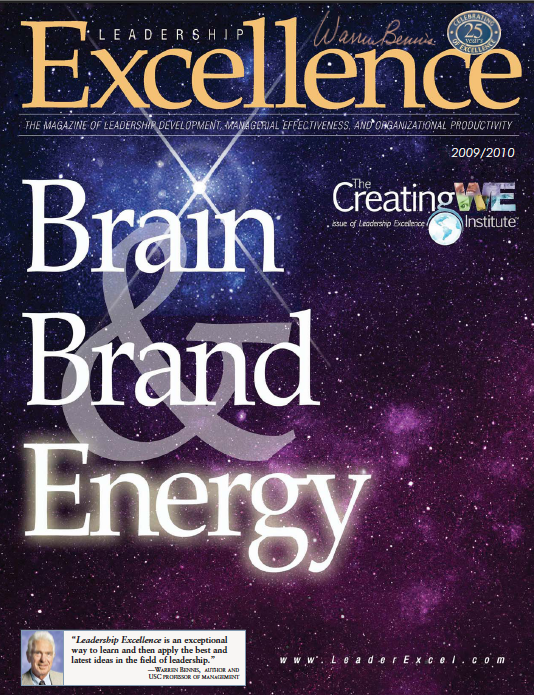By Judith E. Glaser | Leadership Excellence
Published April 2004
Crack the code on culture change.
We spend more time at work than in any other activity. When we join an organization, we enter a new community with expectations to make a difference, to contribute, and to be part of something greater and bigger than we can accomplish on our own. Every person has instincts for greatness. We instinctually want to do well, to contribute, and to be included on the winning team. No one needs to teach us these desires.
Yet many organizations often become harvesters of politics, power, control, arrogance, and egos that fill organizations with invisible street signs that say, “don’t go there,” “you can’t do this,” “you don’t know that,” “save face,” “blame,” and “protect.”
Allowing ourselves to get sucked into territoriality or reactivity can lead to cycles of behavior that erode relationships and take energy away from being productive, healthy, high-performing individuals, teams, and organizations. When we are stuck in territoriality, protecting what we have and fearing loss, we are living at a low level of effectiveness, which ensures we will never achieve our greatest aspirations.
In the face of negativity, positional power struggles, and self-limiting beliefs, our courage and ambition shrivel up. Companies lose their spirit, and mediocrity becomes a way of life. Often, the pattern becomes a death spiral, as we put out the flame needed to thrive. Cracking the code on culture change is easier than most of us think.
Old vs. New Approach
Traditional strategies for culture change come from different disciplines and consulting experience built on a set of beliefs that I want to demystify.
In the old paradigm of thinking, culture change:
- Takes years, if not decades, to do.
- Provokes tremendous fear.
- Incites tremendous resistance.
- Requires changing large systems.
- Requires redesigning processes.
I propose a new approach to culture change. In this approach, I suggest that we all have Vital Instincts that are hard wired into our DNA (like survival skills) and provide us with the codes for how to live healthy, deeply connective, and loving lives with each other.
Vital Instincts give us the intuitive awareness and wisdom to know how to bring together people to form communities, to support each other, and to thrive in the face of challenges. Since the beginning of human history, people have created communities of individuals who traveled to find food, build homes, and create communal life.
 Vital Instincts is the foundation upon which we build our essential wisdom for transforming cultures riddled with politics, power, and dysfunction back into healthy cultures. The secrets are transferable and when practiced have extraordinary power to restore health and growth to individuals and teams.
Vital Instincts is the foundation upon which we build our essential wisdom for transforming cultures riddled with politics, power, and dysfunction back into healthy cultures. The secrets are transferable and when practiced have extraordinary power to restore health and growth to individuals and teams.
The presence of Vital Instincts makes culture change—a topic that has been a mystery—into a science of everyday practice. The Vital Instincts approach is based on discoveries emerging from cancer research at the NYU School of Medicine, where scientists are developing a new technology for curing cancer. Their approach restores natural functioning to cancer cells. By injecting a simple peptide into cancer cells grown in culture, this miraculous peptide reinstructs the cells at the DNA level to act again as healthy cells.
Three Basic Principles
Cancer is an unhealthy state. Cancer depletes life energy from a system. The secret to reinstructing a cancer cell to become a healthy cell again is driven by three basic principles. These principles also apply to changing toxic cultures and relationships back to healthy ones. These simple principles break the code on culture change.
Principle 1: Create a feedback-rich culture. When cancer grows, the cells lose their sensitivity to each other and grow anywhere they can.They invade the body and grow into tumors that can block the normal functioning of organs and the body’s systems designed to sustain health. This principle reminds us of the importance of restoring cell sensitivity and instructs us how.
Translated into business terms, this means creating a feedback-rich culture that enables individuals to establish healthy relationships with their neighbors and coworkers. In a feedback-rich culture, a new level of awareness emerges so that we “don’t grow all over each other.” Rather than creating environments full of territorialism and competition, we learn how to build robust environments full of incredible support, synergies, and expansive possibilities.
Principle 2: Make beliefs transparent. When the body is healthy, the immune system works at all times to ensure that anything that is a threat to health is attacked immediately. Immune system “flags” arise from cells, directing the immune system to know where and how to target their action and to marshal the internal resources to restore health. When cancer forms, normal cells lose these system “flags.” Without them, cancer takes over the body. This principle reminds us of the importance of the immune system “flags” to health and instructs us how to keep the “flags” visible by making our belief systems transparent to each other.
In business, we need to learn how to make our beliefs visible to each other, to become more transparent about what is on our minds, and to audit our mindsets so that we are always operating out of our healthiest beliefs. In a culture where beliefs are transparent, we can collectively monitor the health of our culture, our organization, our teams, and our relationships. With this awareness in place, we can better recognize and reject belief systems that have a negative impact on our ability to create robust environments full of incredible support, synergies, and expansive possibilities.
Principle 3: Focus Outward on Harvesting Growth and Prosperity. Cancer cells multiply by creating their own growth factors. They build their own vascular system (angiogenesis) that supplies oxygen and nutrients to the cancer cells, enabling them to grow at a rapid rate. They become self-sustaining and encapsulated from the rest of the system, drawing out nutrients from inside the system for their own sustenance. Healthy cells, on the other hand, need nutrients from the outside. Since they are serum dependent, they need nourishment from outside to grow. They need to engage with each other for health.
In business terms, this means that we need to be mindful when we are creating an internal view of the world that separates us from others. We can grow this internal view by sapping the nutrients out of the system. Instead, to become healthy, we need to turn outside to others for support, engagement, and nutrition. In a healthy culture, we see people engaged with each other building strong partnerships, collaborating, and synergizing with each other to grow to their next level.
To create a healthy culture, we need to recognize the nutrients we need from each other and to provide them so that we don’t retreat back into ourselves and become self-serving or I-centric. When we become aware of the key nutrients for growth, we are more equipped to release these nutrients into our culture and thrive on them. When we do this, we build robust, we-centric environments full of incredible support, synergies, and expansive possibilities.
Recognizing our Vital Instincts is the first step in understanding how to create positive, healthy environments for growth and generativity. When we master these three principles, we ward off the toxicity that limits life and health. These Vital Instincts principles remind us of the life-giving wisdom we all know at the instinctual level.




